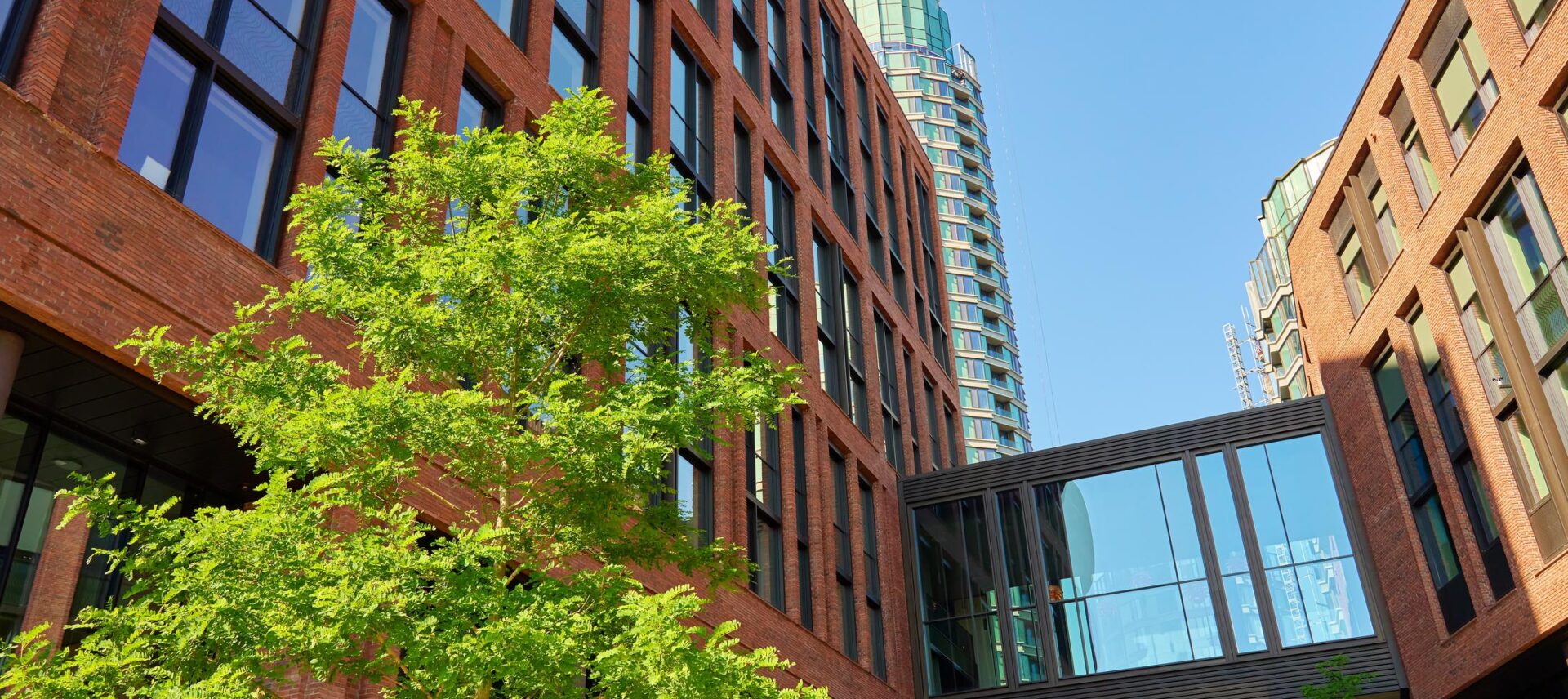News & Insights
Embodied carbon: rethinking construction for a low-carbon future
Decarbonization efforts have long centered on operational emissions, but the conversation is shifting to include the significant impact of embodied carbon in construction. This article delves into the opportunities and obstacles in reducing embodied carbon.

As the built environment continues to focus on reducing emissions, the design and construction industry is turning its attention to a previously overlooked contributor: embodied carbon.
Unlike operational carbon, which arises from energy use during a building’s life, embodied carbon refers to the greenhouse gas emissions generated from extracting, manufacturing, transporting, and installing materials used in construction. This component accounts for a significant portion of total building emissions.
Reducing embodied carbon is becoming an increasingly critical priority for architects, engineers, and construction professionals to meet net-zero targets by tackling the entire carbon footprint.
Why embodied carbon matters now
Historically, the focus on reducing building-related carbon emissions centered around energy efficiency and reducing operational carbon—which is having impact. Advances in energy-efficient design, renewable energy integration, and building performance standards have significantly cut operational carbon. However, as these efforts mature, embodied carbon—often embedded in the supply chains and materials used in construction—has emerged as the next big hurdle.
Embodied carbon is a substantial part of a building’s total emissions, particularly during the construction phase. McKinsey reports that embodied carbon can account for up to half of a building’s total emissions over its entire lifecycle. This issue is particularly pressing in large-scale projects where the construction process and material choices have long-term environmental consequences. Unlike operational carbon, which can be reduced over time through retrofits or improved energy performance, embodied carbon is locked in once the building is constructed. This makes early design decisions, material selection, and construction methods critical in addressing this issue. If addressing embodied carbon is essential for mitigating climate change, then the building industry must evolve its practices to prioritize this reduction goal.
Innovative design practices for embodied carbon reduction
Design plays a pivotal role in determining a building’s carbon footprint, and the earlier embodied carbon is considered in the design process, the greater the potential to reduce it. Innovative design practices today focus on structural adjustments, material selection, and overall project optimization.
One of the most effective strategies for minimizing embodied carbon is to make informed choices during the initial stages of structural design. Opting for materials with a lower carbon footprint, such as mass timber, recycled steel, or alternative concrete additives like fly ash, limestone, or slag, can substantially reduce the environmental impact of new constructions. Additionally, innovative approaches that either decrease the total square footage of the project or repurpose existing structures through adaptive reuse not only diminish emissions but can also lead to significant cost savings. These early decisions set the foundation for a building’s sustainability profile throughout its lifecycle.
Another impactful approach to reducing embodied carbon begins at the material selection phase, where careful consideration of the environmental impact of each material can lead to significant reductions in a building’s carbon footprint. By choosing materials that are sustainably sourced, have lower embodied energy, and are recyclable or reusable at the end of their life, architects and builders can make a substantial difference. For instance, prioritizing materials with Environmental Product Declarations (EPDs) ensures transparency in the carbon emissions associated with their production.
Furthermore, engaging in circular economy practices, such as material banks or modular construction, can extend the lifecycle of materials, reduce waste and so lower the overall carbon footprint of projects. Ultimately, these strategies contribute to a more sustainable and responsible approach to construction, aligning with global efforts to combat climate change.
The role of policy and regulation in driving change
While innovation and material advancements are essential, policy changes are equally critical in reducing embodied carbon across the construction industry. Currently, there are few strict regulations mandating embodied carbon reductions, though there are voluntary policies and guidelines available for those looking to lower their buildings’ carbon footprints.
Governments and industry bodies are beginning to introduce frameworks aimed at curbing embodied carbon, with some cities and regions adopting policies that require life cycle assessments (LCAs) to track carbon emissions during construction. Policies that require carbon footprint reporting or the declaration of carbon emissions in the building sector are starting to create awareness. By making it mandatory to disclose the embodied carbon of a project, these regulations encourage stakeholders to prioritize low-carbon materials and construction techniques from the outset. Although these policies are not yet widespread or stringent, their gradual adoption signals a step-by-step approach toward achieving broader industry goals. As public awareness grows, early-stage decisions regarding material selection and building structure are increasingly being scrutinized.
The future of regulation in this area likely includes stricter mandates on carbon emissions reporting and reductions, incentivizing the use of low-carbon materials, and pushing for greater transparency across supply chains.
Obstacles in reducing embodied carbon
Despite growing awareness and innovation, the building industry still faces significant challenges in reducing embodied carbon. One of the primary obstacles is the lack of widespread awareness, even within the industry. While many stakeholders recognize the need to reduce emissions, they often do not know where to begin or how to effectively tackle embodied carbon.
Another challenge is the limited availability and cost of low-carbon materials. Although promising alternatives exist, they are not always easy to source, and when they are, they can come at a premium. Without robust data on the availability and performance of these materials, it becomes difficult to integrate them into projects in a meaningful way. Also, the lack of standardized tools and methodologies for measuring embodied carbon makes it difficult to compare projects to set a clear target for reduction.
Moreover, there is often a trade-off between cost and sustainability. With low-carbon materials sometimes being more expensive than their traditional counterparts, cost disparity can deter widespread adoption, particularly in markets or regions where budget constraints are a primary concern.
The promising future of embodied carbon reduction in the industry
Looking ahead, several advancements and innovations will shape the industry’s ability to reduce embodied carbon over the next decade. As more data on low-carbon materials becomes available, it will become easier to make informed decisions about material selection based on location, availability, and environmental impact.
The development of advanced tools for analyzing and comparing embodied carbon at the design stage will further facilitate this shift. These tools, which integrate with Building Information Modeling (BIM) systems, will allow architects and engineers to accurately evaluate the carbon footprint of different materials and designs, leading to more sustainable outcomes. In the future, these tools will likely become essential components of the design process, offering real-time analysis and comparisons to guide decision-making.
Practical steps for clients to reduce embodied carbon
For clients looking to reduce embodied carbon in their projects, the most important step is to engage sustainability advisors early in the design process, but ongoing collaboration through the project is just as essential. Early integration allows for more significant adjustments to materials, structure, and design that can substantially lower emissions. This proactive approach also opens up opportunities to explore alternative structural systems, optimize material quantities, and implement adaptive reuse, further minimizing carbon emissions. By conducting lifecycle assessments at the outset, clients can make informed decisions about modular construction, material selection, and other strategies that reduce embodied carbon.
Additionally, maintaining open communication with manufacturers and suppliers is key to sourcing sustainable materials, while designers and engineers can innovate by leveraging digital tools like BIM to simulate and optimize carbon reduction strategies. The entire process is iterative, requiring flexibility to adapt as new technologies and materials become available.
The journey to reducing embodied carbon is one of incremental progress, requiring collaboration across the entire industry. Policymakers, designers, engineers, construction professionals, manufacturers, and clients must join forces to navigate economic challenges, develop innovative materials, and raise awareness.
How Salas O’Brien can help
Salas O’Brien has experts in every area of sustainability. We start by listening and confirming your goals, then we deliver solutions for your unique context. Contact one of our contributors below.

Maria Kordjamshidi, Ph.D, LEED AP, Fitwel Ambassador
Maria Kordjamshidi is an accomplished sustainability consultant and registered architect, specializing in sustainable development and energy-efficient building design. With a proven track record in Canada’s architecture industry, Maria has worked on a wide range of projects, integrating innovative strategies for reducing carbon emissions and enhancing building performance. Her work spans both academia and industry, where she remains deeply committed to advancing sustainable development through cutting-edge research and practical application. Maria serves as a Sustainability Project Manager at Salas O’Brien. Contact her at [email protected].

Lauren Wallace, LEED Fellow, LFA, WELL AP, GRESB AP, WELL Performance Testing Agent, Fitwel Ambassador, Parksmart Advisor, and TRUE Advisor
Lauren Wallace is an architect and visionary consultant who guides organizations towards a future where sustainable practices and profitability go hand in hand. Her unwavering dedication to ESG principles sets her apart as a catalyst for positive change in the business landscape. Lauren serves as a Principal at Salas O’Brien. Contact her at [email protected].

Megan Blizzard, LEED AP BD+C, WELL AP, TRUE Advisor, ActiveScore AP, Fitwel Ambassador, LFA, and Guiding Principles Compliance Professional
Megan Blizzard is an expert in green building procedures and using a sustainable approach to modern-day design and development. A forward-thinker in the challenges of construction and design, Megan enables companies to thrive in the green building industry. Every day Megan succeeds in problem-solving to find optimal solutions for the people, planet, and profit. Megan serves as an Associate Vice President at Salas O’Brien. Contact her at [email protected]